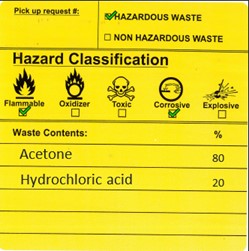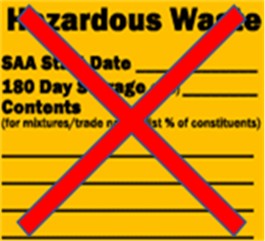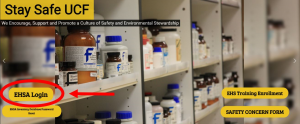Hazardous Waste Guide
Waste Accumulation
Hazardous waste that is generated in labs, shops, studios and maintenance areas must be accumulated in appropriate containers that are compatible with the waste being collected. Place the waste in a leak-proof container with a screw-top lid or other secure closure. Snap caps, such as those found on milk bottles, mix-sized caps, parafilm, or other loose-fitting lids are NOT acceptable. Federal regulations require all waste containers to be properly closed at all times except when adding waste to the container. Solid debris and small liquid vials and containers can be packaged into sealed plastic “Zip-Lock™” bags. Please do not use red biomedical waste bags for hazardous waste unless it exhibits both biohazardous and chemically hazardous properties.
Do NOT overfill containers. Prevent leakage by leaving 3” or more of empty space at the top of the containers. Remember solvents normally generate a high vapor pressure within the containers. Leaving 3”+ of headspace ensures the container will not fail. If a container is found to be leaking, either transfer the contents from the leaking container into new container, or place the entire leaking container into a larger container; this is referred to as an over-packed container. Be sure the overpack container is closed and place it into secondary containment, just as you would do with a primary container. Clean all visible contamination from the outside of the container to prevent possible chemical exposure.
Labeling the Waste
Hazardous waste containers will not be picked up unless they are properly labelled. Waste containers MUST be labeled as soon as any waste is placed in them. Use only the hazardous waste labels provided by EHS (see example below), and be sure to fill them out appropriately and completely. This includes identifying whether the waste is Hazardous Waste or Non-Hazardous waste and identifying the hazards associated with the waste by checking the box below one or more of the pictograms at the top of the label. The label must also identify ALL of the chemical constituents of the container’s contents, and their respective percentages (list must add up to 100%). Contents must be identified with proper chemical names, not chemical formulas (e.g., use Water, not H20).


EHS will provide labels upon request. Use only the latest version of the labels.
Storage
Waste containers need to be stored in secondary containment. Secondary containment needs to be able to contain 110% of the volume of the largest container in said containment. Wastes need to be segregated by type (Flammable, Acids, Bases, Oxidizer, Toxic) within secondary containment. Segregation should be sufficient to allow 2 containers of incompatible waste to fail in a way that will not allow them to mix and react.
Arranging for a Waste Pick-up
Once a container is full, use EHSA to enter a waste pickup request. Follow EHSA waste pickup request entry procedures. One of the most common errors is the container contents entered online do not match the waste contents labeled on the container. This will result in the waste NOT being picked up and the waste request will need to be re-entered correctly. The regulatory maximum allowable quantity of waste in a satellite accumulation area is 55 gallons. Fire code may further limit the allowable quantities, check with your PI. Be sure to not exceed the limits set for your lab.

Resources
EHS and Lab Safety Fact Sheet
Printable Version of Hazardous Waste Guide
Printable Satellite Accumulation Area Guide
Hazardous Waste Safety Contacts
Aaron Young
Environmental Compliance Officer
Aaron.Young@ucf.edu
407-823-0707
Orion Blevins
Environmental Specialist
Orion.Blevins@ucf.edu
407-823-2887